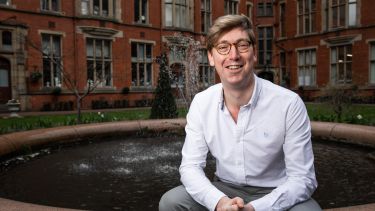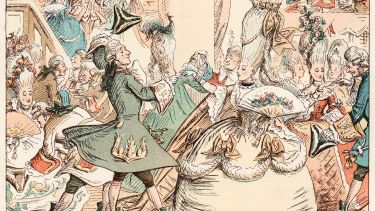How did luxury become a necessity?
Dr Seán Williams provides an insight into the surprising story of luxury and what it means for us today.

Everyone has an opinion on what luxury means to them. For some, it’s being able to have the most expensive champagne whenever they want and for others it’s a lavish holiday four times a year. The general consensus is that wealth equals luxury, but is that actually the case? To coincide with his BBC Radio 3 Documentary, The Deluxe Edition, and guest feature in The Observer, Dr Seán Williams provides an insight into the surprising story of luxury and what it means for us today.
Seán, a lecturer in the School of Languages and Cultures at the University of Sheffield, has been attempting to understand the contentious nature of luxury which began, in the modern sense, in the consumer revolution of the 18th century. His starting point is the historians’ consensus that, despite there being no significant rise in European wages across the 1700s, there was a significant increase in household purchases of high value goods like coffee and watches.
“Prior to the 18th century there were periods and sectors where luxury goods were prevalent,” Seán explains. “But the startling thing about luxury in the 18th century was that a rapidly growing market across Europe occurred alongside the intellectual revolution of the Enlightenment. Luxury was justified as an economic and social asset.”
Luxury became a necessity. It created jobs. No longer exclusively representing status and power such as the monarchy, instead it became part of the mass market. And that saw an explosion in self-expression and pleasure for everyone from labourers to servants. Seán mentions eighteenth century economist Adam Smith’s example of the tweezer box being a prized possession to many. “Luxury was seen as a liberal force,” Seán highlights. And that force had both economical and personal drivers.
The average worker in the 18th century bought luxury goods - like watches and showy clothes - that were incredibly expensive, even though their salary hadn’t increased much, if at all. “They would buy a single conspicuous item, investing a lot of imagination and symbolism into it,” Seán says. At the start of the seventeen hundreds, French servants spent around 10% of their earnings on clothes. By the 1780s, these domestic staff splurged a third of their wages on clothing.
Many of those historical behaviours are still happening today. The luxury market still provides jobs and allows for pleasure and self-expression. But it’s also informing the economic and social picture of high street shopping. In general, brands catering for consumers at the extreme ends of the economic spectrum are having continued success, but mid range high street brands are struggling. This is because “the rich are getting richer and the poor are getting poorer," says Seán, and this supports the stabilisation of companies at either end of the spectrum. However, “what’s not true is that only poor people shop in Sports Direct and only rich people shop in Harrods.”
What’s apparent as Seán explains is that, in 2019, people with limited incomes are investing a disproportionate amount of income into luxury items, much like they did in the 18th century. “It’s not simply the case that luxury is something you buy only when you can easily afford it. If you have nothing you won’t buy luxury items.” Seán explains. “But it’s also clear that today people are prepared to spend a disproportionate amount on luxury items that show how valuable they appear to be...”
Seán’s research emphasis on cultural responses, taken from literature and other media, highlights the importance here of individuals being able to invest symbolism and imagination into their luxury items. This is the same principle that was evident in the 18th century. Symbolism and imagination allows for self expression and gives an impression of opulence to the world which can produce feelings of empowerment and pride.
So perhaps luxury isn’t quite as synonymous with wealth after all. Instead it seems to be thriving on a culture of treating ourselves to the occasional luxury item. After all who doesn’t enjoy the odd glass of champagne or new watch?
- BBC Radio 3 Documentary: The Deluxe Edition
- The Observer feature: Why bling booms when austerity rises
Relevant publications
- Consumption, Creativity and Authors around 1800: The Case of E.T.A
- ”Cancer Coiffures”: Embodied Storylines of Cancer Patienthood and Survivorship in the Consumerist Cultural Imaginary
- E.T.A. Hoffmann und die Alltagskultur um 1800
- On clichés, post-colonialism and the politicisation of Swiss literature: an interview with Martin R. Dean
- With Nora Ramtke, Das Erblühen der Blumenlesen. German Anthologies, 1700-1850
- E.T.A. Hoffmann and the Hairdresser around 1800
Related studies
Seán teaches the German Enlightenment and Romanticism, Thomas Mann, and contemporary Swiss literature. His own module is "The Birth of Consumerism: Britain and Germany".
Seán is available for postgraduate supervision.
Media work
- Liechtenstein, the magic princedom (The Economist 1843)
- Rambling Reflections: On Summers in Switzerland and Sheffield
- Listen: The Rise and Fall of the Hairdresser, BBC Radio 3: New Generation Thinkers
- Listen: A Sentimental Journey, BBC Radio 3: Free Thinking series
- Listen: Louisa Egbunike and Sean Williams, BBC Radio 3: Sunday feature
- Listen: Proms Extra - Sentimentality, BBC Radio 3: Arts & Ideas series
Research profiles
European everyday life around 1800
Sean Williams, The University of Sheffield







